Harry Potter/Characters/Factions
Order of the Phoenix
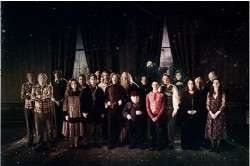
This secret society was created by Albus Dumbledore during the first war against Lord Voldemort, but gradually lost most of its original membership over the course of the war. It went dormant after Voldemort's disappearance, but was reinstated after his resurrection.
The Order of the Phoenix provides and protects opponents of Voldemort, though not always successfully. It has members at Hogwarts and in the Ministry of Magic, as well as in other parts of wizard society. Its members do not have any identifying marks, but communicate by Patronus. They meet in number 12, Grimmauld Place.
The Order is named for Fawkes the phoenix.
- Animal Motifs: All the members use the Patronus to communicate.
- Big Damn Heroes
- Hero Secret Service
- La Résistance
- Mildly Military
Ministry Of Magic
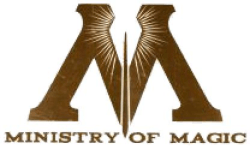
The wizard government of Britain, ostensibly a secret ministry of the Cabinet, but in truth a state unto itself. The Ministry is controlled by the Minister of Magic, who enjoys nearly autocratic powers, and the secretive Wizengamot, making the Ministry a police state on many occasions.
The primary purpose of the Ministry is keep wizards secret from the British public. It is usually very conservative, but becomes fascist after Voldemort takes over. Later on, it is reformed.
- Day of the Jackboot: When Voldemort takes over.
- The Guards Must Be Crazy: The bunch of students easily breaks into the secret labs in OTP. Harry and company comment on this at the time, its implied that the Death Eaters had already been through and countered all the security to let them in.
- Hufflepuff House
- Inspector Javert: The Aurors, to Sirius Black.
- Obstructive Bureaucrat: The Ministry seems to employ quite a few.
- Police Are Useless: These guys don't succeed at the hunting down the Death Eaters. At least, at the Second War.
- Police State: Useless against Voldemort, harsh against its own people.
- Pretentious Latin Motto: The Department of Magical Law Enforcement bears the motto "Ignorantia juris neminem excusat" ("Ignorance of the law excuses nothing").
Death Eaters
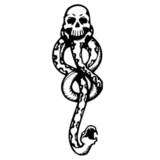
Here come the supporting villains! These are the men and women who follow Voldemort, and the enemies of Harry and his friends. The name of the group comes from their belief that they can "conquer death." Mortal enemies to the Order of the Phoenix, their goal is to exterminate all "impure" wizards, create a new world order in the wizarding society, and (eventually) achieve Immortality - and during both the first and second wars, they are Voldermort's inner circle and act as the elite force in his Army.
Death Eaters are recognizable by the Dark Mark, a magical sign branded into their forearms by Voldemort that burns whenever he summons them to him. The Dark Mark also serves as a Calling Card, which the Death Eaters cast into the sky over the scene of a murder.
Dumbledore describes the Death Eaters as a motley crew of "the weak, seeking reassurance, the ambitious, wanting power and shared glory, and the brutish, gathering around a leader who could show them new forms of cruelty."
- Aerith and Bob: Their names are very different from each other, ranging from "Lucius" and "Bellatrix" to "Evan" and "Peter."
- Aristocrats Are Evil: Several of the Death Eaters come from aristocratic families, though not all of them (there's little that's aristocratic or cultured about Greyback or the Carrows, for example).
- Black Cloak
- Brainwashed: Lucius uses this as a ploy to get out of being arrested.
- Equal Opportunity Evil: Downplayed. While the Death Eaters are willing to work with dark creatures like werewolves and giants that the rest of the wizarding world won't have anything to do with, but those who aren't pureblood wizards will never rise higher than Psycho for Hire.
- Evil Counterpart: To the Order of the Phoenix.
- Five-Bad Band: The top members of the group, including Voldemort himself.
- The Big Bad: Voldemort
- The Dragon: Lucius Malfoy at first, then Bellatrix Lestrange
- The Evil Genius and Sixth Ranger Traitor: Severus Snape
- Another Evil Genius: Barty Crouch Jr.
- The Dark Chick: Peter Pettigrew
- The Brute: Fenrir Greyback
- Names to Run Away From Really Fast
- A Nazi by Any Other Name: More like the KKK than Nazi's rich guys in hoods who dance in circles around a burning symbol in the sky.
- Obviously Evil
- Oddly Small Organization: Partly justified, since they are Voldemort's fanatical inner circle and are sent on all special tasks. The Mooks below them are known as Snatchers, and are not so much an actual organization as an army of collaborators. In the last book, most of their dirty work is done by swarms of inhuman Dementors.
- Putting on the Reich: They view pure-blooded wizards (themselves) as the master race, and their ideology centers on cleansing the world of "mudbloods." Also, in the fourth film, their black robes and pointed hoods intentionally resemble the Ku Klux Klan.
- Not to mention the last two movies (but particularly so the first one): The anti-muggle propaganda pretty much follows the original color scheme, and the security guys at the ministry look like members of the Gestapo, complete with red armbands, which are also worn by the Snatchers.
- Smash Mook: The Carrows, Greyback, the Snatchers...hell, just about any Death Eater not mentioned in the above Five-Bad Band group fits this trope.
Dumbledore's Army

Created by Harry, Ron and Hermione as a response to Dolores Umbridge's prohibition on teaching students to defend themselves against Voldemort, Dumbledore's Army is the Hogwarts equivalent to the Order of the Phoenix. Its members are Hogwarts students who want to fight Voldemort, and they learn defense from Harry in the Room of Requirement. They communicate using gold coins modified by the Protean Charm to display summons.
Though their activities were interrupted by Dolores Umbridge, Dumbledore's Army remained active in the sixth and seventh books, contributing to the defense of Hogwarts. The organization was named by Ginny Weasley, who said that what the Ministry of Magic would most fear was Dumbledore raising his own army.
Gryffindor

This Hogwarts House was founded by Godric Gryffindor and exemplifies courage and honor. Its color is red and gold, its animal is the lion, its ghost is Nearly-Headless Nick, its Head of House is Minerva McGonagall, and it is associated with the element of fire. Most of the heroes in the series are Gryffindors, and their heroics cost their house as many points as they gain for their deeds.
Notable Gryffindors: Harry Potter, the Weasleys, Hermione Granger, Neville Longbottom, Albus Dumbledore, Minerva McGonagall, Rubeus Hagrid, James Potter, Lily Evans, Sirius Black, Remus Lupin, and Peter Pettigrew.
- Big Damn Heroes
- Determinator: Likeable or not, proud or vain, excitable or maligned, nobody in this house ever seems willing to quit.
- Dumb Is Good / Dumb Muscle: One of the few negative labels the house has, at least if one is to believe a young Snape. Makes sense since intelligence, ambition and hard work are all traits that would help one's grades, while bravery isn't.
- Probably that's just an opinion of Slytherin; aversions include Hermione and Dumbledore.
- In Harry Potter and The Half Blood Prince, we encounter two bad Gryffindors, the boastful Cormac McLaggen and the pushy Romilda Vane. Lavender Brown and Parvati Patil similarly seem to be short on courage.
- Enforced Cold War: With Slytherin.
- The Hero: Contributed the most members of any house to Dumbledore's Army, and the most student combatants to the Battle of Hogwarts. Gryffindors like to take charge of things.
- Honor Before Reason: Probably a more accurate negative aspect to the house.
- Only the Chosen May Wield / Sword of Plot Advancement: The Sword Of Gryffindor.
- Screw the Rules, I'm Doing What's Right
Slytherin
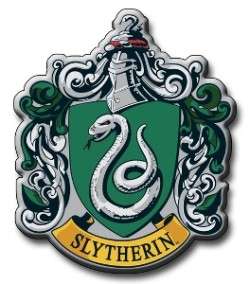
This Hogwarts House was founded by Salazar Slytherin and exemplifies ambition and cunning. Its color is green and silver, its animal is the serpent, its ghost is the Bloody Baron, its Head of House is Severus Snape (later Horace Slughorn) and it is associated with the element of water. Slytherins have a reputation for being underhanded bigots, and their house has the reputation of producing more dark wizards than any other house.
Notable Slytherins include Tom Marvolo Riddle, Severus Snape, Lucius Malfoy, the Blacks, Draco Malfoy, Vincent Crabbe, Gregory Goyle, and Horace Slughorn.
- Alpha Bitch
- Ambition Is Evil: The former Trope Namer.
- Black Sheep: Salazar Slytherin was this to the other Hogwarts founders, due to his pureblood supremacist views.
- Black Shirt
- Dirty Coward: If they're not actually on the side of the bad guys, they tend to be this.
- Enforced Cold War: With Gryffindor.
- Fantastic Racism: Many Slytherin characters we are introduced to have serious Pureblood biases.
- For the Evulz
- Jerkass
- Les Collaborateurs: More Slytherins supported Umbridge than anyone else did, and the Slytherins were also the first to be evacuated during the Battle of Hogwarts so that they would not be able to help the Death Eaters.
- My Species Doth Protest Too Much
- The Usual Adversaries
- Smash Mook: Despite being described as cunning, witty and ambitious, most Slytherins fit this trope, i.e. Crabbe, Goyle, and just about the entire Slytherin Quidditch team.
Ravenclaw

This Hogwarts House was founded by Rowena Ravenclaw and exemplifies intelligence. Its color is blue and bronze, its animal is the eagle, its ghost is the Grey Lady, its Head of House is Filius Flitwick, and it is associated with the element of air. Ravenclaws prize perception and unorthodox thinking, but they also have a reputation for being ivory-tower intellectuals who do not dare to do enough.
Notable Ravenclaws include Helena Ravenclaw, Luna Lovegood, Cho Chang, Filius Flitwick, Roger Davies, and Gilderoy Lockhart.
- Adaptation Dye Job: The house colors, at least, were changed from the original blue/bronze to blue/silver. Likewise, the Animal Motif was changed to a raven from an eagle.
- The Beautiful Elite: Not only are Ravenclaws very intelligent, but also many Ravenclaws are very attractive.
- Hufflepuff House: Though not as bad as the Trope Namer.
- Ice Queen
- The Lancer: Ravenclaw is usually second in the House Cup, and second in the Quidditch Cup.
- Nerds Are Sexy
- Riddle Me This: How to get into the common room, as compared to other houses, who use passwords.
- The Smart Guy
- The Spock
- Teen Genius: Most of its members.
Hufflepuff
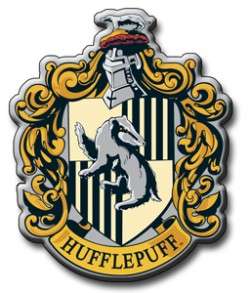
This Hogwarts House was founded by Helga Hufflepuff and exemplifies tolerance and hard work. Its color is yellow and black, its animal is the badger, its ghost is the Fat Friar, its Head of House is Pomona Sprout, and it is associated with the element of earth. Hufflepuff has produced few great wizards, and has the reputation of being the house for those that could not get in anywhere else, but Hufflepuff has perhaps the most decent and humble people of any house.
Notable Hufflepuffs include Pomona Sprout, Cedric Diggory, Nymphadora Tonks, Hannah Abbott, Susan Bones, Ernie Macmillan, Justin Finch-Fletchley, and Zacharias Smith.
- The Big Guy: After Gryffindor, Hufflepuff contributed the most student combatants to the Battle of Hogwarts.
- Butt Monkey: Hufflepuff is definitely the most maligned and mocked house in the fandom as well as canon. Hagrid tells us the first thing we ever hear about Hufflepuff, which is "everyone says Hufflepuff are a load o' duffers," although it's not made clear whether or not he actually agrees with this assessment. In any case, the books imply many times that Hufflepuff doesn't deserve its in-universe reputation as the house of weak-willed idiots.
- Determinator: The House that contributes the most fighters to Hogwarts at the end of the seventh book (after Gryffindor). Loyalty is one of their defining traits.
- The Generic Guy: Their one moment of glory was when Cedric Diggory was chosen as the Triwizard contestant for Hogwarts, which was soon overshadowed by Harry becoming the other contestant for Hogwarts.
- Hard Work Hardly Works: In-universe example, as Hufflepuff House rarely shines compared to the other Houses (noted in Goblet of Fire), despite being the house that hard work is associated with.
- It seems like the difference between Ravenclaw and Hufflepuff is supposed to be the one between gazelles and warthogs. Academically, Hufflepuff students keep plugging at things till they get them and do good studious groundwork. Ravenclaws on the other hand would excel at their talents while neglecting fields that don't interest them, and make breakthroughs that are possible because of the good groundwork in question. It is entirely possible that while the Gryffindors, Slytherins, and Ravenclaws are highly visible, it is the Hufflepuffs who make that visibility possible.
- Hufflepuff House: Trope Namer.
The Slug Club

An informal circle created by Potions master Horace Slughorn to bring together promising young students. Slughorn selects those who are famous, have famous relatives or have demonstrated exceptional talent, and interviews them. If they pass the interview, then they are invited to parties hosted by Slughorn, who also invites alumni who were in the club. This way, he can cultivate connections, ensure that club members become important, and be able to call in minor favors from them.
Members include Horace Slughorn (founder), Voldemort, Lucius Malfoy, Lily Evans, Gwenog Jones, Harry Potter, Hermione Granger, Ginny Weasley, Cormac McLaggen, Blaise Zabini, Marcus Belby (film only), Neville Longbottom (film only), and the Carrow twins (film only).
- Ambition Is Evil: Subverted. The circle is a way for Slughorn to get ahead without directly leading, and getting ahead is the non-bigotry component of the Slytherin credo.
- Dances and Balls
- Dark Is Not Evil: Just because it's an elite circle run by a Slytherin doesn't mean it's bad.
- Expy: Of fraternities and "inner circles" such as the Billingdon Club at Eton or the Skull and Bones.
- Initiation Ceremony: Interview with Slughorn, followed by attendance at a party.
- Lighter and Softer: Compared to the other organizations in the series.
- The Man Behind the Man
- Only Known by Their Nickname: Ron derisively calls it the Slug Club, and the name sticks.
- Wacky Fratboy Hijinx: Averted
- Young Future Famous People: What Slughorn hopes the people in his circle will become.
Dementors
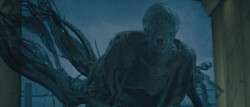
Uncanny creatures in black cloaks that are essentially walking (err, make that floating) Mind Rapes waiting to happen. Initially, they serve the Ministry of Magic as guards for Azkaban, but care nothing for human morality; all they want are victims whose emotions they can feed on, and they're more than willing to switch their allegiance to Voldemort when he offers a better deal. Notable for being Harry's worst fear, because they can use their powers to force him to relive the many traumatic experiences of his life, particularly his parents' deaths.
- Exclusively Evil: Goes with the territory of being personified despair.
- Black Cloak
- The Dreaded
- Emotion Bomb: Despair, mixed with fear.
- Eyeless Face: Which they conceal beneath their hoods.
- The Faceless: Until they attack, at least...
- Fate Worse Than Death: The Dementor's Kiss, where a dementor forcibly extracts its victim's soul from their body, leaving them an empty, but still living, husk. Happens to Barty Crouch Jr in the books and Umbridge in the films.
- The Heartless
- Humanoid Abominations
- The Jailer: Basically their hat, at least during the first part of the series.
- Mind Rape: Merely being in the presence of a dementor causes lite Mind Rape; when there are lots of them, or they actually attack, it gets much worse.
- Names to Run Away From Really Fast
- Nightmare Fuel
- Vader Breath
- The Voiceless: Considering that they're able to work out deals with wizards, they probably have some method of communicating, but never speak on-page.
- Walking Wasteland: The movie versions.
- Write What You Know: J. K. Rowling based the Dementors on her own struggles with depression that she suffered prior to the success of Harry Potter, saying in an interview Dementors are the "absence of being able to envisage that you will ever be cheerful again. The absence of hope. That very deadened feeling, which is so very different from feeling sad."
- Visually, they are based on figures from Rowling's childhood nightmares.
- Your Soul Is Mine: The Dementor's Kiss.